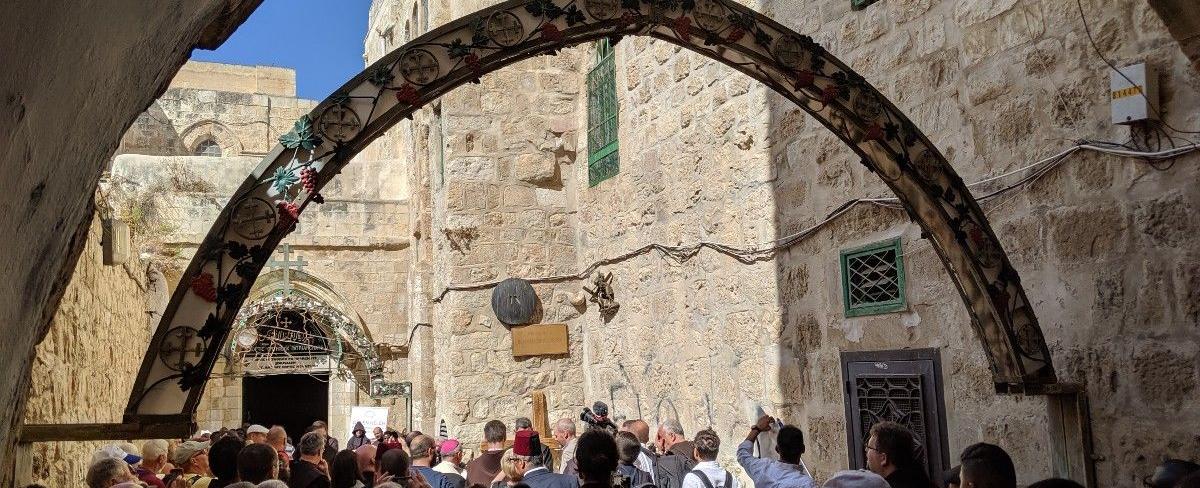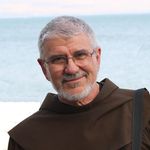The Way of the Cross: Part of Everyday Life in Jerusalem

This blog continues our Lent 2021 series of reflections on the Franciscan Intellectual-Spiritual Tradition by a variety of women and men Franciscans.
When I guide Holy Land pilgrims through the streets of Jerusalem on the Via Dolorosa (Latin for “Sorrowful Way”), we usually share the crowded streets with pilgrim groups from around the world, people of other faiths going about their business, tourists from cruise ships, and merchants standing outside their shops doing business. We are part of everyday life in the Old City.
Way of the Cross imported from Europe
The Via Dolorosa, the route traveled by Jesus on Good Friday, takes pilgrims from the place of his trial before Pilate to his burial in the tomb provided by Joseph of Arimathea. Most Catholics know the 14 stations of the Via Dolorosa, also called the Via Crucis and Way of the Cross, but they may be surprised to learn that the devotion practiced in Jerusalem for centuries was imported from Europe beginning in the sixteenth century.
Jesus was a curiosity
I remind pilgrims that—except for the differences of 20 centuries—Jesus’ ordeal of carrying the cross on that first Good Friday through streets crowded with people was similar: Some may have known this man being led to execution; some were his anguished followers; others could have cared less. To many, Jesus was just a curiosity.
Some events not found in the Gospel
The route we take, and that Franciscans follow every Friday, and especially on Good Friday, at three o’clock in the afternoon, has been established for centuries, but scholars dispute its accuracy. We believe the location of Calvary and the Tomb of Jesus are authentic, but today’s route of the Via Dolorosa may not be Jesus’ path from the place of sentencing to the place of crucifixion and burial. And we know as well that some events in the 14 stations are not found in the Gospel at all.
Christians from the earliest days no doubt visited the site of Calvary and the Tomb. A formal route, with set “stations” came much later.
Taking the practice home to be reproduced
In the fourth century, a Spanish nun, Egeria, describes in her diary how pilgrims followed a route in and around Jerusalem to places associated with the Passion, death, Resurrection and Ascension of Jesus. In succeeding centuries, various routes and processions are recorded. In fact, European pilgrims began taking the practice home so their fellow Christians could reproduce it.
Friars led pilgrims before dawn
After Pope Clement VI gave the Franciscans the care of the Holy Places in 1342, a ritual procession began at “Mount Zion,” outside the city walls, where the friars had their headquarters and commemorated the Last Supper. It continued to include the House of Caiaphas, the palace of Annas, the Mount of Olives, and the Pool of Siloam. These devotions went beyond the events of Good Friday. A later route began at the Holy Sepulchre and included the Garden of Gethsemane. Because Jerusalem at the time was under Muslim rule, the friars led pilgrims in the hours before dawn, so as not to disturb others.
Sole focus on the events of the Passion
The sole focus on the events of the Passion only began in the fifteenth century, but early routes did not include the model of our present-day 14 stations. It was pilgrims coming from Europe, familiar with a version of the Way of the Cross popularized in well-known devotional books, who eventually led Franciscan guides in Jerusalem to begin leading the Way of the Cross largely familiar to us!
Young friars in formation today lead Way of the Cross
A Canadian friar working in the Holy Land, Blessed Frédéric Janssoone, promoted the custom of the Friday afternoon Via Dolorosa. The Franciscans—with young friars in formation usually leading the prayers by megaphone—begin near the Franciscan biblical school and process through the streets to the final five stations within the Church of the Holy Sepulchre. We are usually crowded and rushed as we weave through the streets so we can finish within the time limits imposed by the Status Quo, the agreement that preserves order among Christians serving together in that great church that shelters both Calvary and the Tomb of Jesus.
For a friar, the conclusion of the Via Dolorosa sometimes permits a quick “official” visit inside the shrine over the Tomb, to venerate the place where Jesus was buried and rose from the dead.
Walking Jerusalem streets as Jesus did
Today the Franciscans have created a wonderful audiovisual experience for pilgrims that I love to use. Located near the biblical school, in a room that contains stones from the time of Jesus, the program unfolds the history of Jerusalem and invites modern-day pilgrims to identify with the countless people before them who have walked the streets of the city as Jesus did on that first Good Friday. To you, our brothers and sisters and friends sharing the following audiovisual version of the Way of the Cross, we extend the same invitation.
Greg Friedman, OFM
Author and Journalist
Franciscan Father Greg Friedman is a friar of Our Lady of Guadalupe Province, based in Albuquerque, NM. An author and journalist, he has guided pilgrims in both Italy and the Holy Land. He served as editor of The Holy Land Review, the official magazine of the Franciscan Custody of the Holy Land, from 2017-2020. He offers video reflections on the Sunday readings at www.usccb.org.

